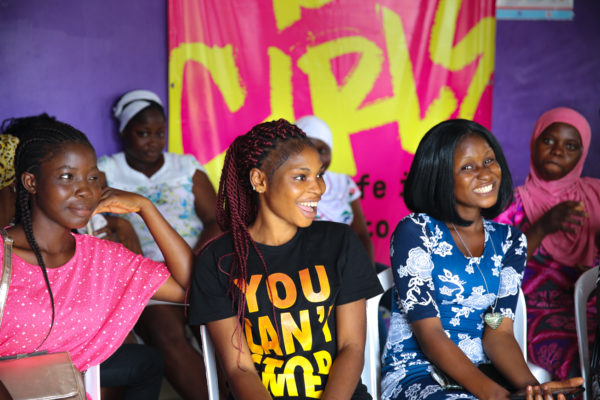By Meghan Cutherell, Senior Program Manager, A360 and Katherine Nichol, Principal Consultant, Strategy Team Lead, Kore Global
The 2023 Women Deliver Conference convened more than 6,000 global leaders, advocates, and experts to discuss and advance gender equality and sexual and reproductive health and rights at scale. During the event, PSI’s Adolescents 360 (A360) program hosted a panel of experts for a candid dialogue on a persistent challenge in the field of adolescent girls’ programming: how to effectively support both girls’ economic power and sexual and reproductive health (SRH) through holistic programming. While a robust body of evidence acknowledges the multifaceted and intersecting challenges faced by adolescent girls, along with the need for holistic program models, there remains limited evidence on how to successfully integrate SRH and economic empowerment program components. The sector knows why integrated programs are important but are left with a need for practical tips and tools on the how.
To tackle this question, PSI’s Adolescents 360 (A360) program turned to five leading experts on adolescent girls programming. The panel at the 2023 Women Deliver Conference included Karen Austrian from the Population Council, Rudo Kayombo from BRAC, Alice Odhiambo from Population Services Kenya, Greta Bull from the Bill and Melinda Gates Foundation, and Fifi Ogbondeminu from Population Services International.
 Read below for our five takeaways from the event.
Read below for our five takeaways from the event.
- Center girls’ voices and experiences
Karen Austrian noted that while there is a well-established evidence base on what works for integrated SRHR and economic programming for women, programs shouldn’t assume that applying this evidence for girls is just a ‘copy/paste’ exercise. Girls and young women’s experiences are unique to their specific life stages. A lifecycle approach – which contextualizes program models to respond to their evolving needs – is crucial to ensure programs deliver the right approaches at the right time.
The A360 project’s experience demonstrates the utility of human-centered design (HCD) – an approach that encourages rapid iteration based on real-time, direct user feedback – as a powerful tool to center girls’ voices and align with girls’ stated needs and preferences. HCD can validate, clarify, and refine the evidence base, ensuring that what works for one population is effectively contextualized to another.
- Acknowledge the influential role of girls’ ecosystems
Girls live in complex ecosystems, comprised of various influential actors such as family, peers, communities, and government. To design holistic solutions to girls’ interconnected challenges, project implementers must engage with these diverse stakeholders.
Integrating girl-centered programming into government systems can help make them more sustainable, but the needs of adolescent girls are too often buried beneath the competing priorities of government actors. Fifi Ogbondeminu, A360’s Global Program Director, suggests the following approach to overcome these challenges: “identify the problem you are working to solve and frame it as a problem [the government] also wants to address.” A360 is working to marry the interests of government health agendas with the needs of adolescent girls to build stronger, more holistic girl-centered programming.
- Use messaging around goals and aspirations as an entry point to establish the relevance of contraceptive use
SRHR programs benefit from the inclusion of economic empowerment content for a number of reasons. In the process of supporting girls to identify their goals, programs are presented with the opportunity to offer the resources needed to achieve those goals, including contraception as a means to prevent an unplanned pregnancy. This aspirational approach, that presents contraception use as a means to reach girls’ goals, is often more compelling than traditional SRHR approaches that try to use sexual activity as a means of establishing the importance of contraceptive use.
Additionally, given the sensitive nature of SRHR topics, layering content around goal setting and skills building can be an entry point for gaining the buy-in of girls and their families or partners for their participation in SRHR programming. The panel emphasized the importance of mitigating any potential risks that would come from ‘flying too far under the radar’ with the SRHR program content.
For example, in A360’s initial phase, we found that our messaging was not direct enough about the services we offered for girls and the SRHR component of our program, creating confusion and hostility among some users and harming the impact of the program.
- Test, pilot, refine and scale
Holistic program models are often criticized for being too expensive and too complex. In order to mitigate these challenges, experts promote the idea of starting small, identifying what works and scaling. This is the foundation of the approach adopted by BRAC, whose Ultra-Poor Graduation (UPG) model represents one example. The program is a comprehensive and sequenced set of interventions to promote sustainable livelihoods and socioeconomic resilience using several elements such as hands-on coaching, enterprise development training, community mobilization and access to healthcare services.
Given that it is a complex program model, it is critical to make a long-term investment and build adaptability into the initial design.
- Address the root causes
The root causes of girls’ lack of economic empowerment and SRHR are the same: inequitable gender norms and limited agency. When combining SRHR and EE programming, both approaches should actively enhance girls’ power and agency. Working at the household, community and government levels is particularly necessary in transforming gender norms; this includes working with men and boys as well as parents.
As the sector refines its approach to holistic programs for adolescent girls, these five tips provide a starting point to more intentionally integrate economic empowerment and SRHR program elements.






